Abstract
The use of molasses as a replacement for bitumen could benefit the pavement industry by improving the performance of the pavement or by lowering its cost. An experimental investigation was carried out to investigate the effect of molasses with different moisture contents on the property of hot-mix asphalt (HMA). Bitumen binders (BB) containing 5%, 10%, 15%, and 20% molasses were investigated as molasses modified binders (MMB). Molasses with 24.9% and 5.02% by weight of water were used to investigate the effect of moisture on the MMBs. In addition to the conventional binder tests, additional tests such as the Fourier transform infrared (FTIR) test, amplitude and frequency sweep test, performance grade (PG) test, and multiple stress creep recovery (MSCR) test were performed. The results indicated that most of the properties of the MMBs improved with the reduction in the moisture content of molasses but worsened with the percentage replacement of molasses. The IR spectra show that the carbonyl index decreased with an increasing amount of molasses. The control grade PG58 was improved to PG64 and PG70 when the base binder was modified with molasses and aged with rolling thin film oven (RTFO) consecutively. At a temperature of 58 °C, non-recoverable creep compliance of 3.2 kPa (Jnr3.2kPa) was decreased for each MMB, which leads to improved rutting potential. At a temperature of 64 °C, the Jnr value was decreased only for the MMB containing 5% molasses, and then gradually increased for the remaining MMBs. Generally, the study revealed that low moisture content molasses could be used as a partial replacement for bitumen to enhance the rheological properties of the bitumen.
1. Introduction
The use of bio-asphalt in asphalt mixtures is currently considered as one of the main alternatives for reducing bitumen consumption, which has environmental, economic, and health benefits [1,2,3,4,5,6,7,8,9,10]. Some of these bio-binders that studied and showed promising results include sugar cane molasses [11,12,13,14], beet molasses [15], swine manure [1,16,17], waste cooking oil [6,9,18,19,20], and wood waste [21,22]. However, the studies indicated that bio-asphalts are moisture susceptible because moisture can have serious effects on the durability of hot-mix asphalt HMA pavements. The use of sugar cane molasses as a replacement for bitumen in pavement construction has less environmental impact and construction cost than that of bitumen. It reduces the greenhouse gas emission by up to 30% and improves the thermal durability of asphalt pavements [23]. In research studies conducted to determine the optimum percentage replacement of bitumen with molasses in the production of HMA, some of the values claimed include 4.7% [13] and 13–15% [24] for 30 viscosity grade bitumen, 0–3% [25], and 9% [12] for 60/70 penetration grade bitumen and 0–10% [15] and 5–20% [11] for 50/70 penetration grade bitumen. The agreement between the research outcomes was that partial replacement of bitumen with molasses can improve the performance of the pavement. Although extensive and valuable studies have been conducted in this field, detailed information on the effects of the water content of molasses on the properties of molasses modified binders, such as rheological properties and chemical compositions, could not be found.
This paper presents the results of an experimental study on the effect of high and low water content sugarcane molasses on the rheological and chemical properties of molasses modified binders used in HMA. Bitumen binders (BB) containing 5%, 10%, 15%, and 20% molasses were investigated as molasses modified binders (MMB). Molasses with 24.9% and 5.02% by weight of water were used to investigate the effect of moisture on the MMBs.
2. Materials and Methods
2.1. Materials
2.1.1. Bitumen
According to the temperature zone mapping for the performance grade (PG) system of Ethiopia, bitumen grade PG58-10 (SHRP, Washington, DC, USA) is the commonly used asphalt binder in most parts of the country, this PG grade is equal with penetration grade P80/100 [26]. Therefore, the same bitumen grade was used in this research. The properties of the PG58-10 bitumen, referred henceforth as the base binder (BB), were determined using the PG test.
2.1.2. Molasses
Molasses (M) is a thick, sticky, dark brown syrup obtained from sugar industries as a waste of sugarcane or sugar beet processing [14]. The molasses used in this research study were sugar cane molasses obtained from Metehara Sugar Factory in Ethiopia, located about 200 km south of Addis Ababa city, and Misraq Shewa Zone of the Oromia Region, it has a latitude and longitude of 08°54′ N 39°55′ E with an elevation of 947 meters above sea level [27].The molasses was used as a partial replacement for petroleum-based neat asphalt (BB) to prepare a bio-asphalt binder or a molasses-modified binder (MMB). The water content of the molasses was initially 24.9% by weight and was reduced to 5.02% using fractional distillation. These two water contents were used to investigate the effect of moisture content on the properties of the MMBs. Molasses was selected as the bio-rejuvenator of BB because they are compatible [7,11,28].
2.1.3. Aggregate
The aggregate used in this research was granite obtained from Deneba, about 350 km southwest of the city of Addis Ababa, Ethiopia. The selection of the gradation was done following the SuperPave® [29] procedure with a nominal maximum aggregate size of 19 mm. SuperPave is a mix design procedure and binder specification developed by a strategic highway research program (SHRP). A SuperPave® gradation curve was selected for good particle interlocking, sufficient voids in mineral aggregate (VMA), and dense-graded HMA [29,30]. All properties of the aggregate were determined in accordance with American Society for Testing and Material (ASTM) or British Standard (BS) procedures, and the test results are presented in Table 1 and Figure 1.

Table 1.
Characteristics of the aggregate.
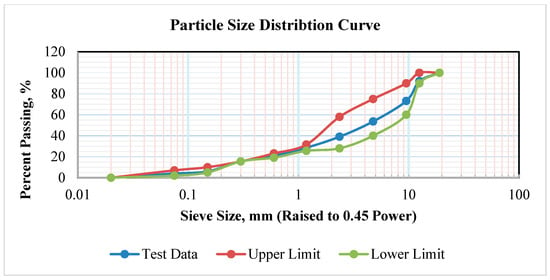
Figure 1.
Particle size distribution curve.
2.2. Methodologies
The first phase of the research study involved determining the properties of the materials used, and the results were compared with the relevant specifications. Water content, penetration, softening point, ductility, flash, and fire point tests were the tests carried out on the binders. In the second phase, the optimal binder content was determined and the value was used as a control for the binder content of the mix. The bio-asphalt binder mix containing 5%, 10%, 15%, and 20% by weight of molasses as a partial placement for the BB was prepared. The study sample range matrix is presented in Table 2. Then; the Fourier transform infrared (FTIR) spectrometer test was carried out on the molasses, BB, and MMBs to know the functional group and the change in the chemical composition of the parent materials before and after blending.

Table 2.
Asphalt binder sample range matrix and definition.
In the third phase, binder specification tests such a rotational thin film oven (RTFO) test, dynamic shear rheometer (DSR) test, frequency sweep test (FST), amplitude sweep test (AST), multiple stress creep recovery (MSCR) test, and PG determination test were carried out to evaluate the high, intermediate, and low-temperature rheological properties and performances of the BB and MMB’s. The entire sequence of the experimental program is presented in Figure 2.
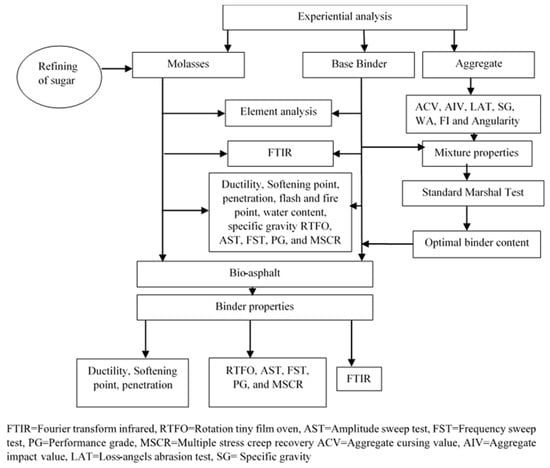
Figure 2.
Flow chart of the research study.
2.2.1. Effect of the Water Content of Molasses on MMBs
The effect of the water content of molasses on the basic properties of MMBs was experimentally investigated by varying the amount of water in molasses. The basic bitumen binder tests carried out include the penetration test to determine the degree of hardness and softness of the binders, softening point(SP) test to determine the viscosity of the binders, the temperature at which the binders reach a flow state, a ductility test to evaluate the adhesive properties of the binders and their ability to stretch and become flexible [31], specific gravity, and water content tests carried out on MMBs containing molasses with 24.9% and 5.02% water content.
The initial 24.9% water content of molasses was reduced to the lowest possible water content of 5.02% using fractional distillation.
2.2.2. Distillation
During the fractional distillation process, the molasses was heated to a temperature of slightly lower than 80 °C, and the resulting water content was 5.02%. The limiting 80 °C was selected because the molasses started to foam at that temperature. Then, BB was uniformly heated using a digital bitumen hot plate at a temperature of 110 °C until it turned into a liquid phase and immediately blended with the preheated molasses per the specified percentages (5%, 10%, 15%, and 20% of molasses). To ensure that the BB was uniformly heated, it was continuously stirred and a temperature measurement was taken using a calibrated thermometer at different locations of the BB. Each blend was mixed using a shear mixer at a speed of 4000 rpm for 30 min to get a homogeneously mixed MMB [6,31,32,33]. The steps followed in the preparation of the bio-asphalt binder are shown in Figure 3.
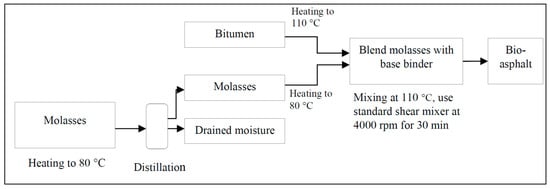
Figure 3.
Modified bio-binder (MMB) preparation.
The effect of the water content of molasses was investigated by comparing the test results of the MMBs with high water content molasses with the results of those containing low water content molasses. The MMB samples from the low water content molasses were also used for rheological tests using Super pave binder specifications.
2.2.3. Fourier Transform Infrared (FTIR) Spectrometer
FTIR is a common method used by organic chemistry to identify the various functional groups, areas, and levels of the peak in a single chemical compound. The FTIR graph illustrates absorbance/transmittance versus the wave number. In this respect, the y-axis shows absorbance ranging from 0–100% and the x-axis represents a wave number ranging from 500 –4000 (>1500 called functional group region and <1500 fingerprint region). The peak is classified as strong, moderate, and weak [34,35].
FTIR spectrometer analysis was carried out on the BB, molasses, and MMBs using Spectrum Two (Waltham, MA, USA) equipment. The functional group and area of the peak were determined, and the fully absorbed and decreased indexes were detected.
The FTIR spectrometer test was performed to evaluate the chemical structure of the aged binder samples before and after the addition of molasses. This study uses parameters such as the carbonyl index(IC=O) and the sulphoxide index (IS=O) to characterize the oxidation of the binder, and quantitative analysis can be performed for the two indexes using Equations(1) and (2) [34,35,36].
2.2.4. Rolling Thin Film Oven (RTFO) Test
Short-term aging and loss on heating tests were carried out using the RTFO test, according to AASHTO T 240 [37] for the BB and MMB [19]. Eight samples were heated in the rolling thin film oven at 163 °C for 85 min, and the loss in mass was determined for each sample.
2.2.5. Dynamic Shear Rheometer (DSR) Test
Bohlin dynamics shear rheometer instrument was used to characterize the rheological properties (Viscous and elastic behaviors) of the aged and unaged BB and BBM’s at low and high-temperature gradients using 8 mm and 25 mm movable plates [38,39]. The rutting index (G*/sinδ) and phase angle of the binders were determined at 0.1 Hz, 1 Hz, and 10 Hz cyclic frequencies. The phase angle was used to characterize the viscoelastic properties of the binders, and the rutting index was used to predict the rutting resistance of the binders.
2.2.6. Performance Grading (PG) Determination Test
The performance grading (PG) test was performed on RTFO-aged and un-aged BB and MMB are using DSR equipment in accordance with AASHTO T-315 [39] testing procedures. The test was carried out in 25-mm diameter plates spaced at 1 mm moving at a constant frequency of 10 rad/s with 10% strain for the RTFO-aged binders and 12% strain for the un-aged binders. The initial testing temperature was 52 °C and was gradually increased until the test was completed. The test was used to determine the permanent deformation parameter (G*/sinδ) and to categorize the PG of the binders.
2.2.7. Frequency Sweep Test (FST)
A frequency sweep test was performed using a DSR SuperPave instrument on the RTFO-aged and un-aged BB and MMBs in accordance with AASHTO-315 [39]. A strain-controlled test with frequency ranging between 0.1Hz and 25Hz was carried out at temperatures of 10 °C, 21.1 °C, 37.8 °C, 52 °C, 58 °C, 64 °C, and 70 °C with a constant strain amplitude. Before conducting the FST, a strain sweep test was performed to measure the limit of the linear viscoelastic (LVE) region for all the binders and the test temperatures. The FST test results were used to construct the isothermal plot, black space diagram, and master curve, which were used to evaluate the rheological property of the binders at different temperatures and frequencies.
2.2.8. Dynamics Modulus Master Curve
The master curve of the complex modulus of the BB and MMBs were constructed using the time-temperature equivalent principle [40,41,42]. The reference temperatures were 58 °C (high), 37.8 °C (intermediate), and 10 °C (low). In this study, a sigmoidal function was used to fit and smoothen the test results at different temperatures and to construct the master curve [43] of the complex modulus by means of Microsoft Excel solver. The principle is shown in Equation (3) [43].
where α, β, δ, and γ are sigmoid function constants, isreduced frequency, and |G*| is a complexshear modulus.
A William–Landel–Ferry (WLF) [44] empirical relationship was used to link the shift factor for each flow curve to master the curve based on the time temperature superposition to obtain the temperature shift factor (a)
where Tref is the reference temperature, C1 and C2 are empirical factors, log (a) is the shift factor, and T is temperature.
where is reduced frequency, f is frequency, and is the temperature shift factor.
2.2.9. Multiple Stress Creep Recovery (MSCR) Test
Bohlin Dynamic Shear Rheometer (DSR) instrument was used to perform a multiple stress creep recovery test for RTFO-conditioned BB and MMB’s in accordance with the AASHTO T-350 standard procedure [45]. The test was used to evaluate the non-recoverable creep compliance (Jnr) and the measure of the potential of a binder to undergo permanent deformation (rutting) under cyclic loading [45,46,47]. During the test, the applied stress level at the outset was 0.1 kPa and, after 10 creep/recover cycles, was increased to 3.2 kPa. The Jnr was calculated as a residual strain in a specimen after creep/recovery cycles divided by the applied stress.
3. Results and Discussions
3.1. Effect of the Water Content of Molasses on MMBs
The experimental test results of the properties of MMBs containing molasses with 24.9% and 5.02% water contents are shown in Table 3. The results of the fire point and flash point tests carried out on the MMBs after their stabilization by lowering the moisture content to 5.02% are presented in Table 4.

Table 3.
Properties of molasses modified binders (MMBs) containing molasses with 24.9% and 5.02% water contents.

Table 4.
Fire point and Flash point test results of MMBs containing molasses with 5.2% water content.
3.1.1. Penetration Resistance
The penetration test results shown in Table 3 indicate that the resistance of the binders increased with the reduction in the water content of molasses. Most of the results of the specimens from the high water content binders exceeded the specified limits while those of the low water content specimens except for MMB20 satisfied the limit. Similarly, the penetration resistance was observed to increase with the content of molasses. The penetration resistance was dropped by 9.85% for MMB5, 12.8% for MMB10, 15.7% for MMB15, and 14.5% for MMB20 when the water content of molasses was reduced by about 80%. Furthermore, the penetration resistance decreases with an increase in the content of molasses. The reduction in penetration resistance of the binders could be due to the water breaking down the weak bond between the molecules of the MMB, which leads to the reduction of its cohesive property. The drop in penetration resistance with an increase in the content of molasses could be related to the increase in the amount of water added to the binders. The more water was added to the binder, the more molecules of the binder will disperse farther apart and the binder may lose its hardness.
3.1.2. Softening Point
The softening point (SP) test results shown in Table 3 indicate that the softening temperature of the binders increased with the reduction in the water content of molasses. Unlike the penetration resistance, the softening temperature was not affected by the molasses content of the binders. The softening temperature was increased by 17.7% for MMB5, 10.6% for MMB10, 14.2% for MMB15, and 18.8% for MMB20 when the water content of molasses was reduced by about 80%. This could be related to the effect of water on viscosity and surface tension. The reduction of water in molasses increases the heat resistance and surface tension between molecules, which improves the viscosity of the binders.
3.1.3. Ductility
The ductility test results shown in Table 3 indicate that the ductility of the binders increased with the reduction in the water content of molasses. No correlation was observed between the molasses’ water content and molasses’ content of the binders because the increase in the ductility was 16.1% for MMB5, 18.8% for MMB10, 17.1% for MMB15, and 11.6% for MMB20 when the water content of molasses was reduced by about 80%. This could be due to the hydrophilic property of molasses, which affects the stability of molecules and leads to a decrease in the intermolecular attraction and surface tension of the MMBs. This phenomenon could result in the reduction of the MMBs’ ability to stretch and become flexible [48].
The ductility of the binders reduced with the content of molasses, irrespective of its moisture content. MMB5 and MMB10 containing low water content molasses were the only binders that satisfied the specified limit for binders. Most of the results of the specimens from the high water content binders exceeded the specified limits while those of the low water content specimens, except for MMB20, satisfied the limit.
Therefore, the presence of moisture has a negative effect on the properties of MMBs when molasses is used as a partial replacement for BB in HMA. When the amount of moisture is reduced, the MMBs have shown some improvements in their properties. To improve the rheological properties of the MMBs, it is necessary to reduce the moisture content of molasses. Since some of the properties of the MMBs did not meet the required specifications at low moisture contents. Additional testing such as Fourier transformation infrared (FTIR) and SuperPave rheological tests was conducted to draw definite conclusions.
3.2. FTIR Test Results
The FTIR test results of the BB, MMB5, and MMB10 are presented in Table 5.

Table 5.
Index from Fourier transform infrared (FTIR) test for Bitumen binders (BB), MMB5, and MMB10.
Table 5 Illustrates that all MMBs recorded higher carbonyl and sulphoxide indexes than that of BB (PG58-10). This indicates that the stiffness behavior and aging potential of BB has-been improved with the addition of molasses.
The FTIR spectroscopy test results are also elaborated on in Figure 4. The figure illustrates that the observed absorbance peaks for M and BB are similar. This could be an indication that there were no significant variations between the functional groups, even if a dehydration chemical reaction took place during the mix of molasses with the control binder BB. In the case of MMB5 and MMB10, peak functional groups between wavenumbers 3550 cm−1 and 3425 cm−1 (Alcohol) disappeared. This indicates that the alcohol has reacted with oxygen at a high temperature during the preparation of the MMBs. Those around wave number 750 cm−1 (Aromamins) were partially absorbed. When primary alcohol was oxidized to an Aldehyde, the O-H (Hydroxyl) bonds in the alcohol were replaced by the C=O bond in the Aldehyde. The functional groups determined using the FTIR test, carried out on three replicate specimens, and are presented in Table 6.
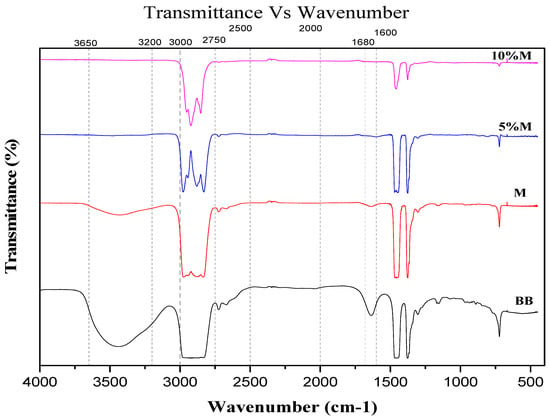
Figure 4.
Spectra of un-aged Bitumen binders (BB), M, MMB5, and MMB10.

Table 6.
Functional groups identified for Molasses (M), Bitumen binders (BB), and molasses modified binders (MMB).
3.3. RTFO Test Results
The RTFO test results, as a percentage loss in mass of BB and MMBs specimens, are presented in Table 7. The results of the two specimens for each mix are presented [49].

Table 7.
Loss on heating for Bitumen binders (BB) and molasses modified binders (MMBs).
According to AASHTO M-320 PG specifications, the mass change in the asphalt binder should not exceed 1% [50]. Based on the specification limit, BBM5 meets the requirements. The results indicate that the loss in mass increases with the increase in the content of molasses. This could be due to the high water content of molasses and the loss of the water by evaporation during aging in the RTFO (163 °C for 85 min). The loss of mass is expected to increase with the increase in the content of molasses.
3.4. Performance Grade (PG)
The rutting resistance parameter G*/Sin of the un-aged and RTFO-aged MMBs are shown in Table 8 and Table 9, respectively. The G*/Sin of the MMBs versus temperature effects were plotted, as shown in Figure 5 and Figure 6. The results were compared with the rheological parameter (G*/Sin) of the control PG [50].

Table 8.
Performance grade determination test result for the un-aged binders.

Table 9.
Performancegradedetermination test result for rolling thin film oven (RTFO)-aged binders.
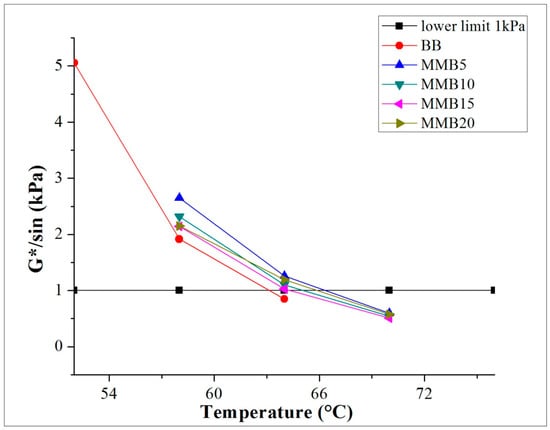
Figure 5.
Performance grade (PG) limit for un-aged binders.
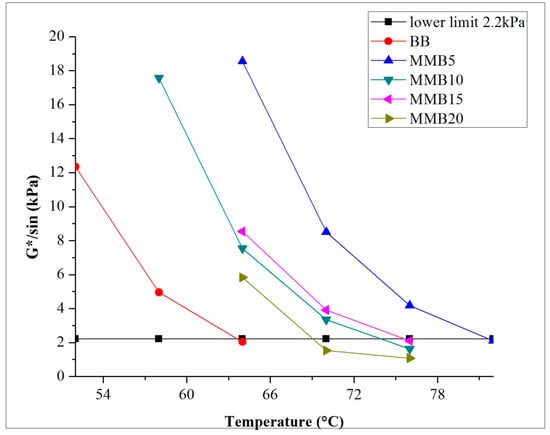
Figure 6.
PG grade limit for rolling thin film oven (RTFO)-aged binders.
The test results of the un-aged binder show an improvement in the performance grade from the control PG58 to PG64 in all MMBs, while those of RTFO-aged improved to PG-70. This result indicates that partially replacing bitumen with sugarcane molasses could increase the stiffness and rheological parameters of the resulting blended binder. Complex shear modulus was increased due to the addition of molasses and RTFO-aging. The increment in the complex shear modulus could mean an improvement in the rutting performance of the binder. To confirm this increment quantitatively, rutting resistance parameters (G*/sinδ) of the unagedMMB5, MMB10, MMB15, and MMB20 were increased by 38.02%, 20.32%, 11.98%, and 11.46%, respectively, at a temperature of 58 °C and by 48.67%, 29.8%, 29.76%, and 20.7%, respectively, at 64 °C. The RTFO-aged samples became stiffer, which led to an increased rutting resistance factor. However, Anderson [51] reported that there is a weak relationship between the stiffness parameter (G*/sinδ) and rutting potential and recommend the multiple stress creep recover test for a strong relationship and to measure the rutting potential accurately [51]. Therefore, the MSCR test was performed to measure the rutting performance and correlate the result with strategic highway research program performance grade (SHRP-PG) [52].
3.5. FST Results
The major rheological parameters, the complex shear modulus, and the phase angle were determined using FST. From the test results, isothermal plots, a black space diagram, and master curves were plotted to characterize the shear stiffness of the binder, to evaluate the effect of molasses on the BB, and to characterize the binder for a wide range of temperatures and frequencies. The black space diagram and isothermal plot for MMB20 are shown in Figure 7 and Figure 8, respectively, as sample diagrams.
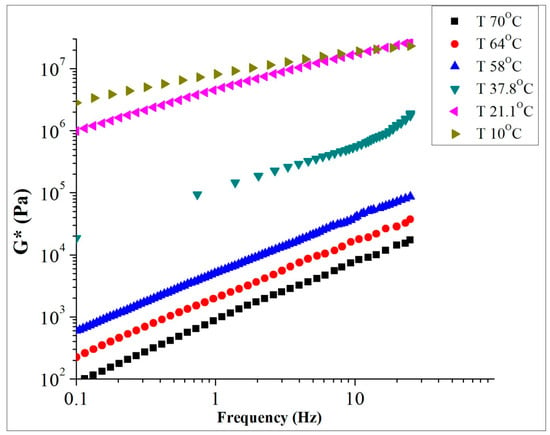
Figure 7.
Log Isothermal plot of MMB20.
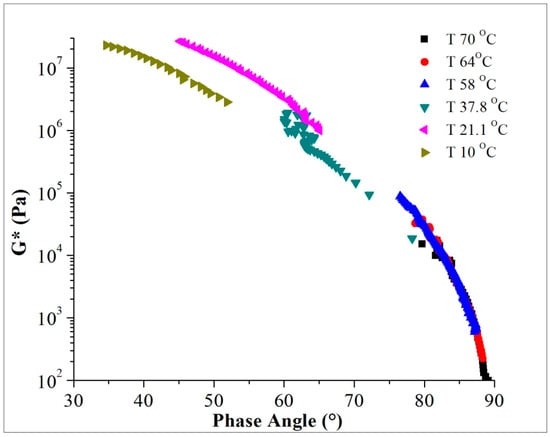
Figure 8.
Semi-log black space diagram of MMB20.
From the FST results, the black space diagram, isothermal plot, and the master curve was developed and presented in Figure 7, Figure 8, Figure 9, Figure 10 and Figure 11. The figures indicate that, at a lower temperature, higher frequency and percentage replacement led to the higher complex shear modulus. But, at a higher temperature, the result was the opposite. An increase in the percentage replacement of molasses from 5% to 20% at higher temperatures led to a decrease in the complex shear modulus. At lower to higher temperature and frequency, the phase angle (δ) of MMB5 and MMB10 gradually increased and then decreased slowly for MMB15 and MMB20.
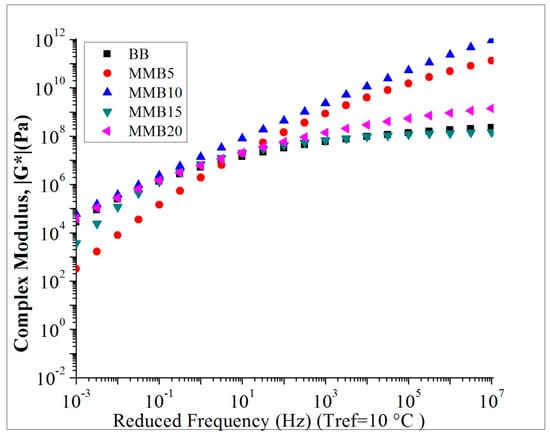
Figure 9.
Lower temperature complex modulus master curve (Tref = 10 °C).
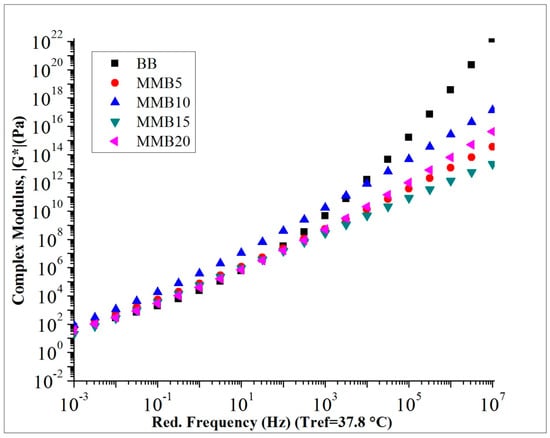
Figure 10.
Intermediatetemperature complex modulus master curve (Tree = 37.8 °C).
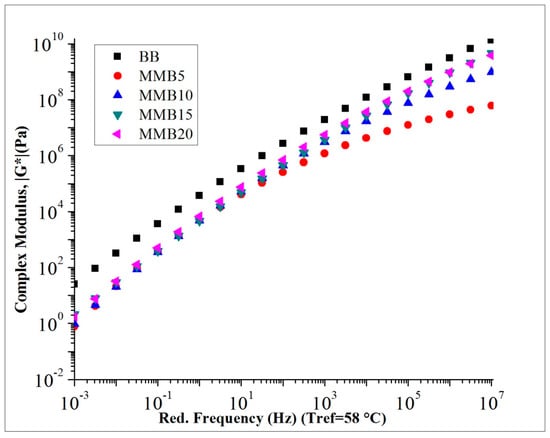
Figure 11.
High-temperature complex shear modulus master curve (Tref = 58 °C).
3.5.1. Low Temperature (Tref = 10 °C)
As observed in Figure 9, the complex modulus and the rutting factor of MMB10 and MMB20 increase from a low to a high frequency range. In the case of MMB5 and MMB15, the complex modulus and rutting factors decreased with the lower frequency (0.1 to 10 Hz.), and the complex modulus increased with the increase in frequency. As the results indicate, MMB5 and MMB15 have less stiffness compared to those of MMB10 and MMB20 at low temperatures and low frequency (slow-moving traffic). However, this result does not lead to a conclusion. Supplementary stress creep recovery tests were performed to evaluate the stress or loading resistance of the binders with different molasses content.
3.5.2. Intermediate Temperature (Tref = 37.8 °C)
As shown in Figure 10, in the lower frequency range of 0.1 to 1000 Hz, the complex modulus and rutting factors of all MMBs were consistent with that of BB. This result indicates that the MMBs have almost the same resistance to rutting as that of the BB. In the high-frequency range, exceeding 1050 Hz, the complex modulus of MMBs reduced, to some extent, compared to that of the BB.
3.5.3. High Temperature (Tree = 58 °C)
Figure 11 indicates that, in the lower to higher frequency range, the complex shear modulus and rutting factors of all MMBs were significantly decreased relative to that of the BB. This result indicates that the MMBs have less resistance to rutting than the BB at high temperatures. This could be attributed to the effect of molasses in lowering the stiffness of BB.
3.6. Multiple Stress Creep Recovery (MSCR) Test Result
From the obtained test results, the average percent recovery, non-recoverable compliance (Jnr), and non-recoverable compliance difference (Jnr Diff.) were determined in two stress levels (0.1 kPa and 3.2 kPa). Jnr at 3.2 kPa is a critical constraint to evaluate the rutting potential. This is summarized in Table 10 and Figure 12.

Table 10.
Summary of multiple stress creep recover test output.
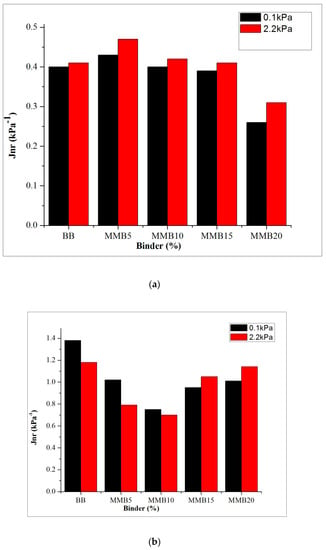
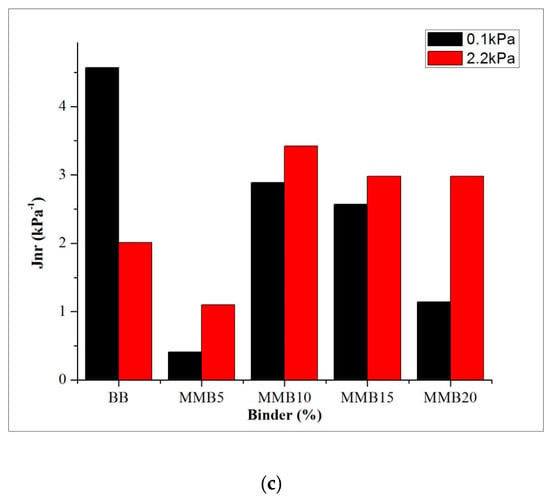
Figure 12.
Noncompliance (Jnr) evaluations at (a) 52 °C, (b) 58 °C, and (c) 64 °C.
Figure 12 presents the calculated non-recoverable creep compliance (Jnr0.1kPa, Jnr3.2kPa) with the change in molasses content at a high temperature. The result indicates that the Jnr value increases as the temperature increases for all the binders. However, at a temperature of 58 °C, the Jnr value is decreased with the increase in the percent replacement of molasses for BB. This led to improving the rutting potential. Furthermore, at a temperature of 64 °C, the Jnr value decreased only for MMR5, and then gradually increased for the remaining MMBs. However, the increment in the Jnr value was within the ASSHTO M-332 [52] specification limit. Therefore, the rutting resistance of binders containing a large amount of molasses should be evaluated cautiously.
According to AASHTO M-332 [52], the maximum J_nr3.2 value of the standard (S), heavy (H), very-heavy (V), and extremely heavy (E) traffic conditions are ≤4 , ≤2 , ≤1 , and ≤0.5 , respectively. This indicates that the Jnr3.2 value decreased from 4 to 0 when the traffic loading is increased from standard to extremely heavy. The MSCR result of this study has been presented in Table 10 and clearly defined the PG with a traffic designation for each of the MMBs and BB. This result shows that the J_nr3.2 value increases as the temperature increases for all MMBs. At a temperature of 52 °C, the results indicate that there were no significant variations on the traffic designation PG52E for all MMBs and the BB. The traffic designation of BB, MMB15, and MMB20 exhibited similar PG and traffic PG58H. However, the traffic loading was improved from PG58H to PG58E for MMB5 and from PG58H to PG58V for MMB10.
The accumulated (total) strain with respect to time was calculated using a semi-empirical equation equations [53,54,55] and is based on the phase angle (δ) and shear complex modulus (G*).
Figure 13 and Figure 14 show that the accumulated strain was influenced by the percentage of the molasses used. Smaller values of accumulated strain were obtained for MMB5, which is followed by BB, MMB10, MMB15, and MMB20 for a 3.2 kPa stress level and BB, MMB15, MMB20, and MMB10 for a 0.1 kPa stress level. From this, it can be concluded that MMB5 could better improve the resistance to rutting phenomena compared to the MMBs with higher molasses content.
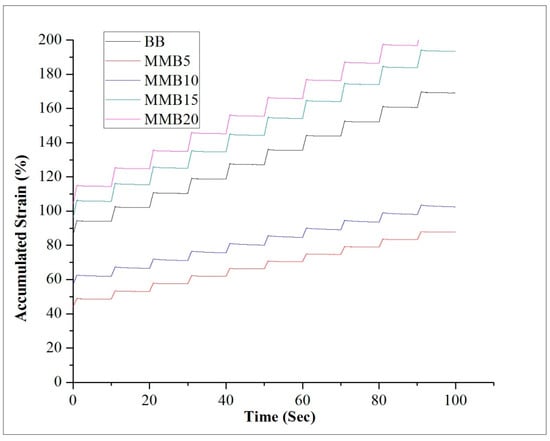
Figure 13.
Cumulative total strain of binders at 0.1 kPa (58 °C)
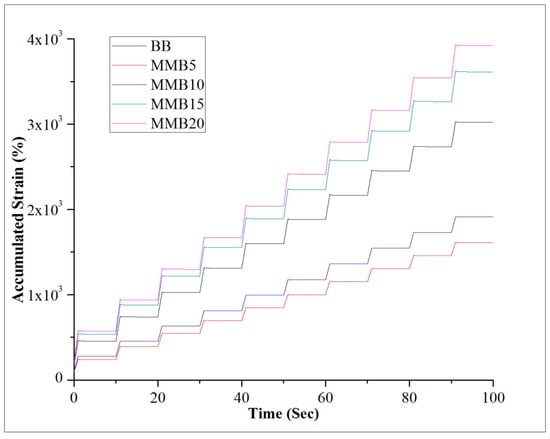
Figure 14.
Cumulative total strain of binders at 3.2 kPa (58 °C)
4. Conclusions
- This research comprehensively evaluated the effect of using molasses as a modifier for neat bitumen in HMA using detailed experimental investigations. Based on the results obtained, the following conclusions have been made. The water content of molasses has a direct effect on the properties of the molasses’ modified binder. The properties of the binder are negatively affected by the increase in the moisture content of molasses.
- Within a wavenumber range of 3550 cm−1 and 3425 cm−1, the Alcohol (O-H stretching) fully reacted with the functional group and, around wave number 750 cm−1; Aromamins (C-H stretching) had partially reacted with the functional group.
- At low temperatures, the complex shear modulus of the molasses’ modified binders increased with the increase in the content of molasses. However, at high temperatures, the complex shear modulus decreased. Therefore, molasses improves the rutting resistance of the bitumen binder at a low temperature.
- PG determination tests confirmed that neat bitumen does not undergo a major change in the PG before and after RTFO aging. However, when the percentage of the bio-binder was increased, the complex shear modulus increased, which resulted in improving the PG from PG58 to PG64. After the RTFO aging condition, PG58 became PG70.
- The non-recoverable creep compliance (Jnr) of molasses’ modified binder increases as the temperature increases. A reduced Jnr value of the binders at 58 °C could result in improved rutting resistance potential.
- Overall, this study revealed that molasses treated for water content reduction could be used as a partial replacement for the bitumen binder to enhance the rheological properties of the binder and to produce a sustainable bio-asphalt binder.
Author Contributions
Conceptualization, W.H. and T.G., methodology W.H., data collection W.H., data analysis, W.H, validation, W.H. and T.G., paper formatting, T.G., original draft writing, W.H., revision and editing, T.G., research supervision, T.G. All authors have read and agree to the published version of the manuscript.
Acknowledgments
This material is based upon work supported by the Ministry of Science and Higher Education of the Federal Democratic Republic of Ethiopia under Grant No. 23A742. Any opinions, findings, and conclusions, or recommendations expressed in this material are those of the author(s) and do not necessarily reflect the views of the Ministry of Science and Higher Education. The authors are thankful to Texas Tech University and Jimma Institute of Technology for their support.
Conflicts of Interest
The authors declare no conflict of interest.
References
- Fini, E.H.; Kalberer, E.W.; Shahbazi, A.; Basti, M.; You, Z.; Ozer, H.; Aurangzeb, Q. Chemical Characterization of Biobinder from Swine Manure: Sustainable Modifier for Asphalt Binder. J. Mater. Civ. Eng. 2011, 23, 1506–1513. [Google Scholar] [CrossRef]
- Kowalski, K.J.; Król, J.; Radziszewski, P.; Casado, R.; Blanco, V.; Pérez, D.; Viñas, V.M.; Brijsse, Y.; Frosch, M.; Le, D.M.; et al. Eco-Friendly Materials for a New Concept of Asphalt Pavement. Transp. Res. Procedia 2016, 14, 3582–3591. [Google Scholar] [CrossRef]
- Yang, X.; You, Z.; Mills-Beale, J. Asphalt Binders Blended with a High Percentage of Biobinders: Aging Mechanism Using FTIR and Rheology. J. Mater. Civ. Eng. 2014, 25, 864–870. [Google Scholar] [CrossRef]
- Mills-Beale, J.; You, Z.; Fini, E.; Zada, B.; Lee, C.H.; Yap, Y.K. Aging Influence on Rheology Properties of Petroleum-Based Asphalt Modified with Biobinder. J. Mater. Civ. Eng. 2014, 26, 358–366. [Google Scholar] [CrossRef]
- Sun, Z.; Yi, J.; Huang, Y.; Feng, D.; Guo, C. Properties of Asphalt Binder Modified by Bio-Oil Derived from Waste Cooking Oil. Constr. Build. Mater. 2016, 102, 496–504. [Google Scholar] [CrossRef]
- Sun, D.; Sun, G.; Du, Y.; Zhu, X.; Lu, T.; Pang, Q.; Shi, S.; Dai, Z. Evaluation of Optimized Bio-Asphalt Containing High Content Waste Cooking Oil Residues. Fuel 2017, 202, 529–540. [Google Scholar] [CrossRef]
- Dong, Z.; Yang, C.; Luan, H.; Zhou, T.; Wang, P. Chemical Characteristics of Bio-Asphalt and Its Rheological Properties after CR/SBS Composite Modification. Constr. Build. Mater. 2019, 200, 46–54. [Google Scholar] [CrossRef]
- Tayh, S.A.; Muniandy, R.; Hassim, S.; Jakarni, F.; Aburkaba, E. An Overview of Utilization of Bio-Oil in Hot Mix Asphalt. WALIA J. 2014, 30, 131–141. [Google Scholar]
- Gao, J.; Wang, H.; You, Z.; Hasan, M.R.M.; Lei, Y.; Irfan, M. Rheological Behavior and Sensitivity of Wood-Derived Bio-Oil Modified Asphalt Binders. Appl. Sci. 2018, 8, 919. [Google Scholar] [CrossRef]
- Bahadori, A.; Li, R.; Zhang, K.; Xin, J.; Muhunthan, B.; Zhang, J. Performance Evaluation of Hot Mix Biobinder. In Airfield and Highway Pavements; American Society of Civil Engineers: Reston, VA, USA, 2019; pp. 255–265. [Google Scholar]
- Mose, G.Y.; Ponnurangam, P. Investigating the Effect of Cane Molasses on the Performance of Base Bitumen. Int. J. Res. Innov. Appl. Sci. 2019, III, 54–58. [Google Scholar]
- Abdulahi, T. Partial Replacement of Asphalt Bitumen with Sugarcane Molasses. Master’s Thesis, Addis Ababa Institute of Technology, Addis Ababa, Ethiopia, 2017. [Google Scholar]
- Prakash, K.S.; Phanindra, M.; Surya, S.R.; Naresh, J. Percentage Replacement of Bitumen with Sugarcane Waste Molasses. Int. J. Civ. Eng. Technol. 2014, 5, 188–197. [Google Scholar]
- M’Ndegwa, J.K. Diversifying the Use of Molasses Towards Improving the Infrastructure and Economy of Kenya. Civ. Environ. Res. 2016, 8, 37–42. [Google Scholar]
- Gürü, M.; Çubuk, M.; Arslan, D.; Aminbakhsh, S. Effects of Sugar Beet Molasses and Molasses-Based Boron Oxide Compound on Bitumen Properties. J. Mater. Civ. Eng. 2016, 4016252. [Google Scholar] [CrossRef]
- Fini, E.H.; Al-Qadi, I.L.; You, Z.; Zada, B.; Mills-Beale, J. Partial Replacement of Asphalt Binder with Bio-Binder: Characterisation and Modification. Int. J. Pavement Eng. 2012, 13, 515–522. [Google Scholar] [CrossRef]
- Walters, R.C.; Fini, E.H.; Abu-Lebdeh, T. Enhancing Asphalt Rheological Behavior and Aging Susceptibility Using Bio-Char and Nano-Clay. Am. J. Eng. Appl. Sci. 2014, 7, 66–76. [Google Scholar] [CrossRef]
- Rasman, M.; Hassan, N.A.; Hainin, M.R.; Putra Jaya, R.; Haryati, Y.; Shukry, N.A.M.; Abdullah, M.E.; Kamaruddin, N.H.M. Engineering Properties of Bitumen Modified with Bio-Oil. In Proceedings of the MATEC Web of Conferences, Johor, Malaysia, 27–28 August 2018; Volume 250. [Google Scholar] [CrossRef]
- Sun, D.; Lu, T.; Xiao, F.; Zhu, X.; Sun, G. Formulation and Aging Resistance of Modified Bio-Asphalt Containing High Percentage of Waste Cooking Oil Residues. J. Clean. Prod. 2017, 161, 1203–1214. [Google Scholar] [CrossRef]
- Wang, C.; Xue, L.; Xie, W.; You, Z.; Yang, X. Laboratory Investigation on Chemical and Rheological Properties of Bio-Asphalt Binders Incorporating Waste Cooking Oil. Constr. Build. Mater. 2018, 167, 348–358. [Google Scholar] [CrossRef]
- Zhang, R.; You, Z.; Wang, H.; Chen, X.; Si, C.; Peng, C. Using Bio-Based Rejuvenator Derived from Waste Wood to Recycle Old Asphalt. Constr. Build. Mater. 2018, 189, 568–575. [Google Scholar] [CrossRef]
- Yang, X.; You, Z.; Dai, Q. Performance Evaluation of Asphalt Binder Modified by Bio-Oil Generated from Waste Wood Resources. Int. J. Pavement Res. Technol. 2013, 6, 431–439. [Google Scholar] [CrossRef]
- Vignesh, H.; Ramesh, N.G.; Manivasagan, V.; Suganya, S.; Eajas, M. Emerging Trends in Greener Pavements. Int. J. Eng. Res. Technol. 2013, 2, 1–4. [Google Scholar]
- Mizan, T.; Filimon, M.; Haftom, G.; Tsigereda, T.; Meseret, D.K.A.A.G. Assessing the Property of Molasses as a Bitumen Replacement; Dire Dawa University: Dire Dawa, Ethiopia, 2014. [Google Scholar]
- Shah, V.V.; Dave, H.K.; Raol, H.J.; Kalasareeya, D.D. A Study on Changes in Rheological Behaviour of Paving Grade Bitumen Using Admixtures. Int. J. Sci. Res. Dev. 2015, 3, 2024–2028. [Google Scholar]
- Mahlet, G. MahletGahsawMihretu and HabtamuMelese. Mapping Temperature Zone of Ethiopia for Binder Performance Grading System. Master’s Thesis, Addis Ababa University, Addis Ababa, Ethiopia, 2018. [Google Scholar]
- Francom, M.G.; Counselor, A. Ethiopia Aims to Become One of the World’ s Top 10 Sugar Producers; GAIN Report ET1532: Africa and Middle East, Ethiopia, 10 November 2015; p. 16. [Google Scholar]
- Melbourne. EcopaveAustralia GEO320 Technology. Available online: http://www.ecopave.com.au (accessed on 21 December 2015).
- U.S. Department of Transportation. Performance Testing for Superpave and Structural Validation; Georgetown Pike; United States Federal Highway Administration: Washington, DC, USA, 2012.
- Swami, B.L.; Mehta, Y.A.; Bose, S. A Comparison of the Marshall and Superpave Design Procedure for Materials Sourced in India. Int. J. Pavement Eng. 2004, 163–173. [Google Scholar] [CrossRef]
- Barco Carrión, A.J.; Lo Presti, D.; Pouget, S.; Airey, G.; Chailleux, E. Linear Viscoelastic Properties of High Reclaimed Asphalt Content Mixes with Biobinders. Road Mater. Pavement Des. 2017, 18, 241–251. [Google Scholar] [CrossRef]
- Al-Omari, A.A.; Khedaywi, T.S.; Khasawneh, M.A. Laboratory Characterization of Asphalt Binders Modified with Waste Vegetable Oil Using SuperPave Specifications. Int. J. Pavement Res. Technol. 2018, 11, 68–76. [Google Scholar] [CrossRef]
- Mansourian, A.; Gholamzadeh, S. Moisture Susceptibility of Hot Mix Asphalt Containing Asphalt Binder Modified with Nanocomposite. Road Mater. Pavement Des. 2017, 18, 1434–1447. [Google Scholar] [CrossRef]
- Griffiths, P.R.; De Haseth, J.A. Fourier Transform Infrared Spectrometry, 2nd ed.; Wiley-Inter science: Hoboken, NJ, USA, 1967; Volume 42. [Google Scholar] [CrossRef]
- Berthomieu, C.; Hienerwadel, R. Fourier Transform Infrared (FTIR) Spectroscopy. Molecular Mechanisms of Uranium Tolerance View Project Radionuclide-Protein Interactions View Project Fourier Transform Infrared (FTIR) Spectroscopy. Photosynth. Res. 2009, 157–170. [Google Scholar] [CrossRef] [PubMed]
- Lamontagne, J.; Dumas, P.; Mouillet, V.; Kister, J. Comparison by Fourier Transform Infrared (FTIR) Spectroscopy of Different Ageing Techniques: Application to Road Bitumens. Fuel 2001, 80, 483–488. [Google Scholar] [CrossRef]
- AASHTO T 240. Standard Method of Test for Rolling Thin Film Oven Test for Asphalt Binders; American Association of State Highway and Transportation Officials: Washington, DC, USA, 2014; pp. 1–6. [Google Scholar]
- Zhang, R.; Wang, H.; Jiang, X.; You, Z.; Yang, X.; Ye, M. Thermal Storage Stability of Bio-Oil Modified Asphalt. J. Mater. Civ. Eng. 2018, 30, 04018054. [Google Scholar] [CrossRef]
- AASHTO T 315-10. Standard Method of Test for Determining the Rheological Properties of Asfhalt Binder Using a Dynamic Shear Rheometer (DSR); American Association of State Highway and Transportation Officials: Washington, DC, USA, 2010. [Google Scholar]
- Witczak, M.W.; Kaloush, K.; Pellinen, T.; El-Basyouny, M.; Von Quintus, H. Simple Performance Test for Superpave Mix Design; Transportation Research Board: Washington, DC, USA, 2002. [Google Scholar] [CrossRef]
- ARA, Inc. Guide for Mechanistic-Empirical Design of New and Rehabilitated Pavement Structures; ARA, Inc.: Lombard, IL, USA, 2003. [Google Scholar]
- Han, J.; Moraga, C. The influence of the sigmoid function parameters on the speed of backpropagation learning. Comput. Sci. 1995, 930, 195–201. [Google Scholar]
- Malcolm, L.W.; Robert, F.L.; John, D.F. The Temperature Dependence of Relaxation Mechanisms in Amorphous Polymers and Other Glass-forming Liquids. J. Am. Chem. Soc. 1995, 77, 3701–3707. [Google Scholar]
- Witczak, M.W. Development of Master Curve (G*) Data Base for Lime Modified Asphaltic Mixtures; Arizonasstat university: Tempe, AZ, USA, 2004. [Google Scholar]
- AASHTO T 350-19. Standard Method of Test for Multiple Stress Creep Recovery (MSCR) Test of Asphalt Binder Using a Dynamic Shear Rheometer (DSR); American Association of State Highway and Transportation Officials: Washington, DC, USA, 2019; p. 8. [Google Scholar]
- Subhy, A. Advanced Analytical Techniques in Fatigue and Rutting Related Characterisations of Modified Bitumen: Literature Review. Constr. Build. Mater. 2017, 156, 28–45. [Google Scholar] [CrossRef]
- Domingos, M.D.; Faxina, A.L. Susceptibility of Asphalt Binders to Rutting: Literature Review. J. Mater. Civ. Eng. 2015, 28, 04015134. [Google Scholar] [CrossRef]
- Zeng, M.; Pan, H.; Zhao, Y.; Tian, W. Evaluation of asphalt binder containing castor oil-based bioasphalt using conventional tests. Constr. Build. Mater. 2016, 126, 537–543. [Google Scholar] [CrossRef]
- AASHTO T 240. Effect of Heat and Air on a Moving Film of Asphalt Binder (Rolling Thin-film Oven Test); American Association of State Highway and Transportation Officials: Washington, DC, USA, 2013. [Google Scholar]
- AASHTO M 320-16. Standard Specification for Performance-Graded Asphalt Binder; American Association of State Highway and Transportation Officials: Washington, DC, USA, 2016; p. 8. [Google Scholar]
- Anderson, M. Understanding the MSCR Test and its Use in the PG Asphalt Binder Specification 2011. Available online: https://docplayer.net/43840781-Understanding-the-mscr-test-and-its-use-in-the-pg-asphalt-binder-specification-r-michael-anderson-asphalt-institute-31-august-2011.html (accessed on 21 December 2015).
- AASHTO M 332-19. Standard Specification for Performance-Graded Asphalt Binder Using Multiple Stress Creep Recovery (MSCR) Test; American Association of State and Highway Transportation Officials: Washington, DC, USA, 2019; p. 7. [Google Scholar]
- Peralta, J.; Williams, R.C.; Silva, H.M.R.D.; Machado, A.V.A. Recombination of Asphalt with Bio-Asphalt: Binder Formulation and Asphalt Mixes Application. Asph. Paving Technol. Assoc. Asph. Paving Technol. Tech. Sess. 2014, 83, 1–36. [Google Scholar]
- Behnood, A.; McDaniel, R.; Shah, A.; Olek, J. Analysis of the Multiple Stress Creep Recovery Asphalt Binder Test and Specifications for Use in Indiana; (Joint Transportation Research Program Publication No. FHWA/IN/JTRP-2016/07); Purdue University: West Lafayette, IN, USA, 2016. [Google Scholar] [CrossRef]
- Zhang, R.; Dai, Q.; You, Z.; Wang, H.; Peng, C. Rheological Performance of Bio-Char Modified Asphalt with Different Particle Sizes. Appl. Sci. 2018, 8, 1665. [Google Scholar] [CrossRef]
© 2020 by the authors. Licensee MDPI, Basel, Switzerland. This article is an open access article distributed under the terms and conditions of the Creative Commons Attribution (CC BY) license (http://creativecommons.org/licenses/by/4.0/).